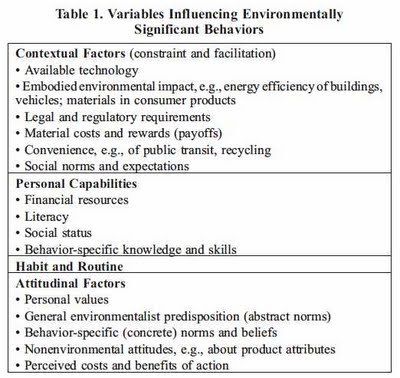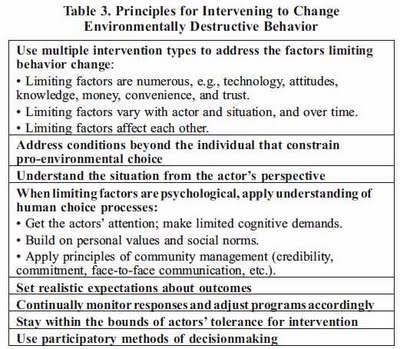Paul Stern of the Division of Behavioral and Social Sciences and Education at the UK’s National Research Council, proposes a sensible way to strategise the choice between involuntary and structural approaches to influencing peoples’ environmental behaviours.
He writes:
“The influences on environmentally significant behavior…can be roughly classified as shown in Table 1. Generally speaking, the stronger the contextual influences (those toward the top of the table), the less important are the personal factors toward the bottom.
“This pattern of influences implies that effective laws and regulations, strong financial incentives or penalties, irresistible technology, powerful social norms, and the like can leave little room for personal factors to affect behavior…
“The pattern of influences on behavior also implies that when contextual influences are weak, the personal factors at the bottom of the table are likely to be the strongest influence on behavior.
“Also, when the contextual factors cannot be changed, the personal factors may provide the only levers on behavior, even if they are weak or only apply in restricted situations.
“In most real-world contexts, both contextual and personal factors are involved in shaping environmental behavior, so a variety of factors are potentially available for bringing about behavior change. For example, the environmental impact of traveling to work is usually shaped largely by the location of home and of workplaces, the availability of public transportation, the fuel economy of an individual’s motor vehicles, and habit. But even with behavior that is as strongly context-determined as commuting, personal factors can matter, particularly at key decision times. These include the times when people obtain new vehicles, make choices about their maintenance, and, particularly when their homes or workplaces change, making it relatively easy to form new commuting habits.”
TRANSLATION: When people don’t really have much choice about their behaviours, focus on structural change.
He also suggests some principles for designing interventions:
“The complexities of person-situation interactions and a careful reading of the research lend support to a set of general principles for behavior change such as listed in Table 3.
TRANSLATION: When people don’t really have much choice about their behaviours, focus on structural change.
He also suggests some principles for designing interventions:
“The complexities of person-situation interactions and a careful reading of the research lend support to a set of general principles for behavior change such as listed in Table 3.
Paul C. Stern (2005) Individuals’ Environmentally Significant Behaviour, Environmental Law Reporter News and Analysis 35 10785<o:p></o:p>


